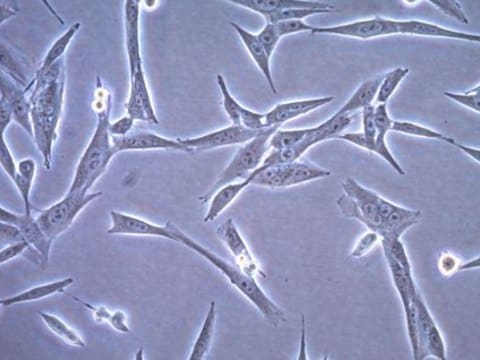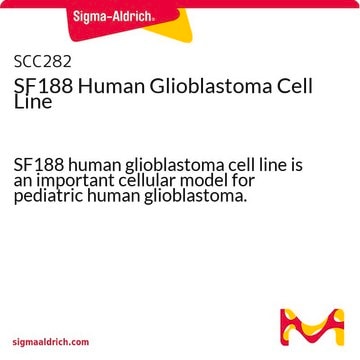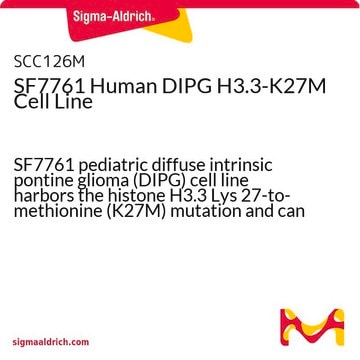SCC179
SMA-560 Mouse Orthotopic Glioma Cell Line
SMA-560 cell line is a well-established glioma model derived from a spontaneous murine astrocytoma.
Synonim(y):
P560, SMA 560, SMA560
Zaloguj sięWyświetlanie cen organizacyjnych i kontraktowych
About This Item
Kod UNSPSC:
41106514
NACRES:
NA.45
Polecane produkty
metody
cell culture | mammalian: suitable
Opis ogólny
The SMA-560 cell line is a well-established glioma model derived from a spontaneous murine astrocytoma (2,3). SMA560 cells are highly reflective of differentiated anaplastic astrocytoma, having high expression of the differentiated astrocyte marker glial fibrillary acid protein (GFAP) and the astrocyte marker glutamine synthetase and low expression of S-100 proteins (4,5). The SMA560 cell line maintains robust tumorigenic behavior after serial passaging (2). Uniquely among established murine glioma models, SMA560 cells express the immunosuppressive protein transforming growth factor β (TGF-β) (6), making this cell line of great value for investigation of targeted cancer immunotherapies.
Source:
SMA-560 cell line was derived from a spontaneous astrocytoma passaged in syngenic VM/Dk mice (2).
Gliomas are a rare and aggressive cancer with an extremely low survival rate and high resistance to treatment (1). Glioma models that recapitulate the multiple features of the disease are important for understanding of mechanisms of glioma malignancy and development of effective therapies, especially those that address tumor-induced immunosuppression and resistance.
References:
1. N Engl J Med 2005; 352(10): 987-996.
2. Acta Neuropathol 1980; 51(1): 53-64.
3. Neurosci Lett 1982; 34(3): 315-320.
4. J Neurol Sci 1983; 62(1-3): 115-139.
5. J Neurol Neurosurg Psychiatry 1986; 49(12): 1361-1366.
6. Neurosurgery 1997; 41(6): 1365-1372.
Source:
SMA-560 cell line was derived from a spontaneous astrocytoma passaged in syngenic VM/Dk mice (2).
Gliomas are a rare and aggressive cancer with an extremely low survival rate and high resistance to treatment (1). Glioma models that recapitulate the multiple features of the disease are important for understanding of mechanisms of glioma malignancy and development of effective therapies, especially those that address tumor-induced immunosuppression and resistance.
References:
1. N Engl J Med 2005; 352(10): 987-996.
2. Acta Neuropathol 1980; 51(1): 53-64.
3. Neurosci Lett 1982; 34(3): 315-320.
4. J Neurol Sci 1983; 62(1-3): 115-139.
5. J Neurol Neurosurg Psychiatry 1986; 49(12): 1361-1366.
6. Neurosurgery 1997; 41(6): 1365-1372.
Opis linii komórkowej
Cancer Cells
Zastosowanie
SMA-560 cell line is a well-established glioma model derived from a spontaneous murine astrocytoma.
Opakowanie
≥1X10⁶ cells/vial
Jakość
- Each vial contains ≥ 1X10⁶ viable cells.
- Cells are tested negative for infectious diseases by a Mouse Essential CLEAR panel by Charles River Animal Diagnostic Services.
- Cells are verified to be of mouse origin and negative for inter-species contamination from rat, chinese hamster, Golden Syrian hamster, human and non-human primate (NHP) as assessed by a Contamination Clear panel by Charles River Animal Diagnostic Services
- Cells are negative for mycoplasma contamination.
Przechowywanie i stabilność
Store in liquid nitrogen. The cells can be cultured for at least 10 passages after initial thawing without significantly affecting the cell marker expression and functionality.
Oświadczenie o zrzeczeniu się odpowiedzialności
This product is intended for sale and sold solely to academic institutions for internal academic research use per the terms of the “Academic Use Agreement” as detailed in the product documentation. For information regarding any other use, please contact licensing@emdmillipore.com.
Unless otherwise stated in our catalog or other company documentation accompanying the product(s), our products are intended for research use only and are not to be used for any other purpose, which includes but is not limited to, unauthorized commercial uses, in vitro diagnostic uses, ex vivo or in vivo therapeutic uses or any type of consumption or application to humans or animals.
This page may contain text that has been machine translated.
Kod klasy składowania
12 - Non Combustible Liquids
Klasa zagrożenia wodnego (WGK)
WGK 1
Temperatura zapłonu (°F)
Not applicable
Temperatura zapłonu (°C)
Not applicable
Certyfikaty analizy (CoA)
Poszukaj Certyfikaty analizy (CoA), wpisując numer partii/serii produktów. Numery serii i partii można znaleźć na etykiecie produktu po słowach „seria” lub „partia”.
Masz już ten produkt?
Dokumenty związane z niedawno zakupionymi produktami zostały zamieszczone w Bibliotece dokumentów.
Nasz zespół naukowców ma doświadczenie we wszystkich obszarach badań, w tym w naukach przyrodniczych, materiałoznawstwie, syntezie chemicznej, chromatografii, analityce i wielu innych dziedzinach.
Skontaktuj się z zespołem ds. pomocy technicznej







